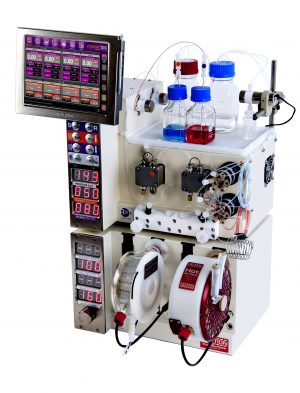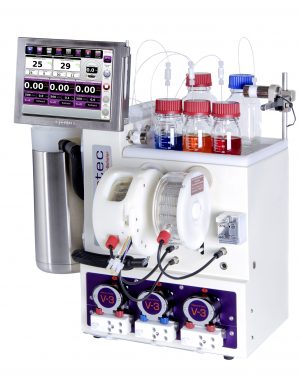In situ epoxide generation by dimethyldioxirane oxidation and the use of epichlorohydrin in the flow synthesis of a library of β-amino alcohols
Peter J. Cossar, Jennifer R. Baker, Nicholas Cain, Adam McCluskey
- Chemistry, The University of Newcastle, University Drive Callaghan, New South Wales 2308, Australia
Read the publication that featured this abstractThe flow coupling of epichlorohydrin with substituted phenols, while efficient, limits the nature of the epoxide available for the development of focused libraries of β-amino alcohols. This limitation was encountered in the production of analogues of 1-(4-nitrophenoxy)-3-((2-((4-(trifluoromethyl)pyrimidin-2-yl)amino)ethyl)amino)propan-2-ol 1, a potential antibiotic lead. The in situ (flow) generation of dimethyldoxirane (DMDO) and subsequent flow olefin epoxidation abrogates this limitation and afforded facile access to structurally diverse β-amino alcohols. Analogues of 1 were readily accessed either via (i) a flow/microwave hybrid approach, or (ii) a sequential flow approach. Key steps were the in situ generation of DMDO, with olefin epoxidation in typically good yields and a flow-mediated ring opening aminolysis to form an expanded library of β-amino alcohols 1 and 10a–18g, resulting in modest (11a, 21%) to excellent (12g, 80%) yields. Alternatively flow coupling of epichlorohydrin with phenols 4a–4m (22%–89%) and a Bi(OTf)3catalysed microwave ring opening with amines afforded a select range of β-amino alcohols, but with lower levels of aminolysis regiocontrol than the sequential flow approach.
Get in touch
For more information on flow chemistry systems and services please use the contact methods below.
Call us on +44 (0)1284 728659 or Email us
Resource Centre
R-Series

The Vapourtec R-Series is, quite simply, unrivalled for flow chemistry
- Flexible |
- Precise |
- Automatable
The R-Series is undoubtedly the most versatile, modular flow chemistry system available today.
E-Series

The Vapourtec E-Series is the perfect introductory system for flow chemistry
- Robust |
- Easy to use |
- Affordable
The E-Series is a robust and affordable, entry level flow chemistry system designed for reliability and ease of use.
